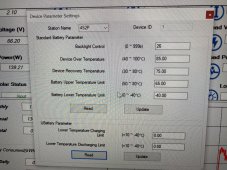What is the float voltage? That would be even lower around 26.8? Seems odd to get to 30+ in just a couple seconds while floating.
Have you contacted epever?
Quick google search indicates this is a general problem with this controller.
Cloud edge effect or large change in load will effect the charging voltage and the MPPT is too slow to adjust. Seems like poor voltage regulation in general to me. I would reduce the float voltage for testing. With a charge limit of 28.8 the controller should never go above that voltage.
I recommend Morningstar controllers if you are spending money.
https://www.cheaprvliving.com/forums/showthread.php?tid=40172&page=2
I have seen over voltage issues from a inverter on a system with a epever charge controller. It took a while to figure it out but on a day with partial clouds the cloud effect was causing the voltage to get above 15 volts. The charge controller just doesn't sample the voltages fast enough to respond to the cloud effect and can take seconds to recognize that the battery voltage has changed. The delay can be seen both in cloud effect and when a heavy load is applied. The inverters remote panel showed the difference in voltage a few seconds before the charge controller did.
Due to this I no longer suggest epever as a low cost alternative in my designs. Especially those with Lithium batteries that are not going to appreciate high voltage.
Yep, everything that Jimindenver said. I had two different Epever controllers and both did the same thing, allowing a voltage spike over the 15.6 volt input limit on my inverter and triggering its high voltage protection and alarm. The second controller was that BN4215. Happened with the cloud effect and also while driving when trees would momentarily shade the panels, also pulling out from under gas station canopies. Constantly having to stop to restart the inverter. The worst was taking off on a long hike or bike ride and returning hours later to hear that alarm and find the inverter shut down so the refrigerator lost power. I switched to Victron mppt 2 1/2 years ago, never had another problem. I had other issues with those Tracer/Epever controllers but that's another topic.
Have you contacted epever?
Quick google search indicates this is a general problem with this controller.
Cloud edge effect or large change in load will effect the charging voltage and the MPPT is too slow to adjust. Seems like poor voltage regulation in general to me. I would reduce the float voltage for testing. With a charge limit of 28.8 the controller should never go above that voltage.
I recommend Morningstar controllers if you are spending money.
https://www.cheaprvliving.com/forums/showthread.php?tid=40172&page=2
I have seen over voltage issues from a inverter on a system with a epever charge controller. It took a while to figure it out but on a day with partial clouds the cloud effect was causing the voltage to get above 15 volts. The charge controller just doesn't sample the voltages fast enough to respond to the cloud effect and can take seconds to recognize that the battery voltage has changed. The delay can be seen both in cloud effect and when a heavy load is applied. The inverters remote panel showed the difference in voltage a few seconds before the charge controller did.
Due to this I no longer suggest epever as a low cost alternative in my designs. Especially those with Lithium batteries that are not going to appreciate high voltage.
Yep, everything that Jimindenver said. I had two different Epever controllers and both did the same thing, allowing a voltage spike over the 15.6 volt input limit on my inverter and triggering its high voltage protection and alarm. The second controller was that BN4215. Happened with the cloud effect and also while driving when trees would momentarily shade the panels, also pulling out from under gas station canopies. Constantly having to stop to restart the inverter. The worst was taking off on a long hike or bike ride and returning hours later to hear that alarm and find the inverter shut down so the refrigerator lost power. I switched to Victron mppt 2 1/2 years ago, never had another problem. I had other issues with those Tracer/Epever controllers but that's another topic.
Last edited:




